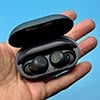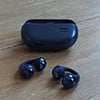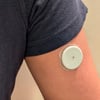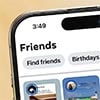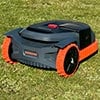We may earn commissions when you buy from links on our site. Why you can trust us.
JLab Hear Review: What You Can Expect From $100 OTC Hearing Aids
You are reading correctly. JLab’s Hear OTC hearing aid-slash-Bluetooth buds are just $100 – $99.99, to be precise.
And they don’t suck. Well, they kinda do. They don’t exactly provide natural-sounding ambient sound boost like more expensive hearing aids – they certainly amplify sounds adequately, but they sound mostly thin, sharp, and hollow. But, after all, what do you expect from hearing aids that only cost a hundred bucks?
The JLab Hear are a really cheap introduction to non-prescriptive hearing aids that could help you determine if over-the-counter hearing aids work for you. If you decide OTC hearing aids will work for you – just not the JLab Hear – and you opt for a better, real-world-priced solution, just keep the Hear around for emergencies.
Hear does include more features than I expected. You get two separate sets of silicone ear tips: small, medium, and large “closed” tips which help isolate sound for music listening and hands-free calls, and S-M-L perforated “open” tips that mix ambient with amplified sound designed to create more naturally sounding boosted conversation. There’s also a variety of both app and on-bud touch audio and play/pause controls for not only music and phone calls but volume as well.
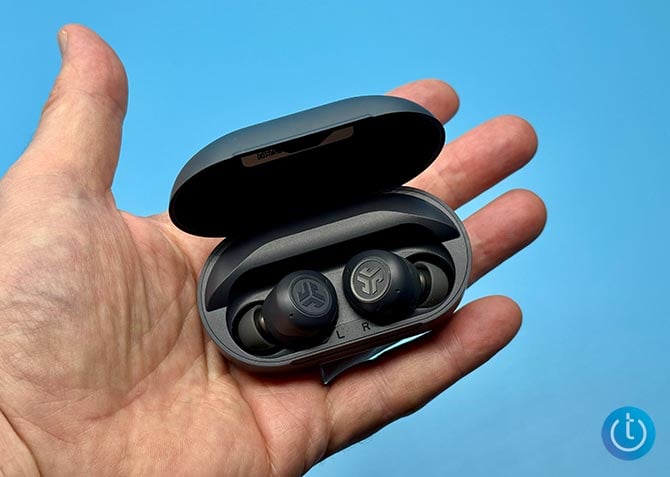
| + Pros | – Cons |
|
|
Setup
Hear are easy to set up, especially since there’s a handy USB-C charging cord connected right to the bottom of the small case. Once fully charged, there are video instructions in the JLab Hearing app (not to be confused with JLab’s regular Bluetooth bud app) to help you pair the Hear, guide you about the ear tips, and demo the variety of on-bud tap volume and play controls.
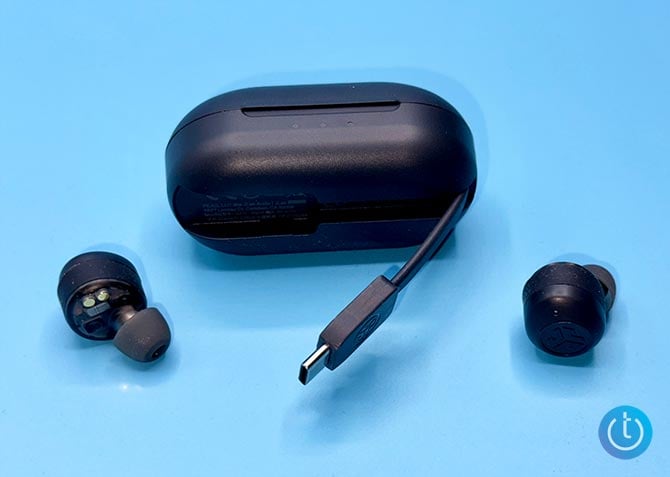
Along with the different-size ear tips, you also get circular silicone “cush fins” that wrap around the buds to help stabilize them in your ears, but you’ll have to remove them so the buds fit back in the case for recharging. For an extra $10 you can buy a set of closed S-M-L foam ear tips.
Battery Life
One of the Hear’s more interesting bonuses or drawbacks, depending on their usage, is their battery life. With Bluetooth on and a mix of music and hearing aid use, I got the rated 7-10 hours of power from a single charge, far more than most music-only Bluetooth buds. While a healthy battery life for Bluetooth buds, 10 hours falls far short of the usually necessary “all-day” hearing aid powering.
You can switch off the Hear’s Bluetooth connection and just use the buds as hearing aids to stretch the battery for another hour or so. You just need to return the buds to the case to switch back and forth between Bluetooth on and off.
It takes two hours to fully recharge the case and two hours to recharge the buds either via USB-C or just in the disconnected case. The case provides a full extra charge.
Design and comfort
The Hear buds look just like most other round Bluetooth ear buds rather than the Apple AirPod-like sticks.
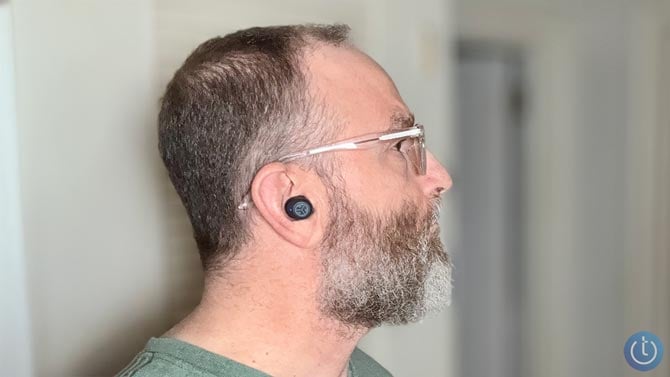
You can buy the Hear in one of three colors: graphite black, a golden “beige,” and an off-white “cloud.” You get a 30-day return window and a surprisingly lengthy two-year warranty.
While the Hear buds don’t “disappear” from feeling them in your ears as do more expensive “invisible” buds such as the standard hearing-aid-only Eargos and the Sony CRE-C20, the Hear are light and remained perfectly comfortable in my ears for a continuous 10 hours of wear. Even without the cush fins, the buds felt secure in my ears, reliably stayed in place, and rarely needed to be adjusted.
Read more: Sony's New CRE-C20 Are the Best OTC Hearing Aids I've Tested
However, the Hear on-bud touch controls are sensitive; when I did need to adjust the buds’ fit, I often accidentally either paused or started the music playing.
On-bud and in-app controls
In the app, you can adjust a number of audio settings as long as your Bluetooth is connected, a lot more adjustment options than I expected for $100 buds.
You can set the buds to four different ambient environments: Loud, Restaurant, Conversation, Quiet. Each can be toggled on or off, which limits the number of taps you’d need to make to toggle through the environments via the buds’ touch controls.
The Quiet and Restaurant environments heightened the upper treble frequencies, Restaurant seemed to highlight the midrange, while the Loud Environment slightly heightened more of the lower frequencies, but all these sonic variations are subtle. I advise picking one setting that sounds good at home for “normal” environments and just turn the others off.
Adjusting the app’s 10-band equalizer didn’t seem to impact sound at all. A sliding Remove Background Noise control helps shape ambient sound, but I found setting it to the extreme “less noise” produced warbly sound as the buds constantly readjusted their amplification setting and often completely muted themselves for a few seconds before re-adjusting.
Hear allows you to adjust left and right volume separately or synchronized. There are only four levels of loudness, but I found each level louder also slightly increased fuzzy distortion on higher frequency sounds.
All in all, you have a lot of ways to adjust the sound to match your hearing loss, far more than you’d need if the buds simply included a hearing test to automatically set the appropriate frequency levels to your particular hearing needs like self-fitting aids.
Sound Quality
Hear provides generous audio settings and control options, but not so much sound quality.
Amplified audio quality for both music and especially conversation and TV sound leans toward the hollow, fuzzy, and shrill, especially at higher volumes. Hear does boost volume reasonably well – depending on which ear tips you wear.
With the “open” tips, you’ll get more natural-sounding amplified conversation, not just as natural as more expensive hearing aids. But Bluetooth music with the “open” tips barely qualifies as background sound and is drowned out almost entirely in noisier situations such as on a crowded street or on mass transit.
With the “closed” tips, Bluetooth music listening is more sound-isolating but still barely adequate – your music listening isn’t aided like it is on the self-fitting Apple AirPods Pro 2. When you pause music, Hear takes around five seconds for their transparency mode to activate and start amplifying ambient sound, but your own voice is muted during conversation. Hands-free phone calls and brief conversation interludes when you pause the music, however, both sound relatively clear and clean.
Read more: AirPods Pro 2 as Hearing Aids Review: Revolutionary, but Flawed
The bottom line

For $100, the JLab Hear with the open ear tips make a fine introductory and comfortable hearing aid for everyday use around the house or office, superior in both sound quality and feature adjustments to most cheap late-night-TV advertised “hearing aids” but hardly comparable to pricier self-fitting buds. Those with moderate or more severe hearing loss will need to boost the Hear volume, which can cause distortion.
With closed eartips, Hear are fine for running errands with musical accompaniment and conducting intermittent chats with vendors or cashiers when the music is paused.
But if you’ve got moderate or more specific hearing loss and you also want a decent wireless music listening experience, I’d opt for more expensive self-fitting Bluetooth hearing aids such as the Apple AirPods Pro 2 ($249, usually on sale for $190) or the HP Hearing Pro ($499).
[Image credit: Stewart Wolpin/Techlicious]

